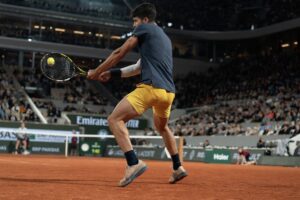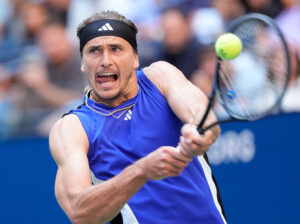Eight-time champion Roger Federer made his way into the second week at Wimbledon for the 17th time after dispatching Cameron Norrie in four sets. Federer has played tight at times so far. But he has also played well in all three matches, which has given him confidence heading into the fourth round. He will face Lorenzo Sonego, who beat James Duckworth to reach the Round of 16 for the first time.
Federer will have to step up his game as the tournament progresses, as he will face tougher opponents who may be able to break down his game. There are still some pitchy spots and concerns in his game. If he fixes them, it can land him deep into the second week of SW19. So, what can Federer tweak, improve, or change?
Roger Federer at Wimbledon 2021
Serve
The serve is unfortunately one of Federer’s weaknesses for now. It’s clearly visible that Federer isn’t using his serve to its full potential in terms of pace and speed. He is using the serve to set up points to his preference, but isn’t aiming on shorting the point with aces. He used to have a lot of depth, power, and accuracy, which made his serve one of his main weapons in the past. It’s still there, but Federer appears to be hesitant to fully unload, which could be due to his knees. He wants to avoid overstretching or injuring himself by remaining cautious.
One of Federer’s main problems with his serve is his inconsistency during points; in many of his matches, he was playing longer and closer service games because he wasn’t getting the buffer from his serve, which can cost him service games games against the top players. If the 39-year-old can improve his serve accuracy and speed, he will be able to configure the points to his preference and avoid having to play tighter service games.
Forehand
The Roger Federer forehand has been his most powerful weapon throughout his career, allowing him to convert defense into offense and always staying in control of points. Federer doesn’t need to play nearly as much defense as the other top players because of his command on the forehand. On grass, speed is one of the most important aspects of the forehand. Flatter and faster forehands are very rewarding when it comes to working with the surface.
One issue with Federer’s forehand right now is that he’s hitting the ball too conservatively with a lot of topspin, resulting in short balls with little power and depth. Federer is constantly put on defense as a result of this flaw, which prevents him from finishing points quicker. In comparison to 2017, when Federer won Wimbledon without dropping a set, his forehand was much flatter and contained a lot more power and depth, depriving the opponent of time.
Since there is more topspin on Federer’s forehand, it means a higher ball trajectory over the net, landing in an ideal position for the opponent to attack on either stroke, forcing Federer to run or putting the point away at the net. This strategy works well on clay, where the balls bounce slower and higher, making it difficult to attack because the ball would land much higher. On grass, balls bounce lower, so with higher topspin the ball would land very normally without much depth.
Federer should fix this by hitting his forehand flatter and faster, which would give him an advantage in rallies and allow him to dictate play, which he did so well in the years he won the tournament. Initially, hitting flatter may reduce the amount of safe margin and accuracy he has, but it will pay off in crucial moments of the match.
Break Point Conversion
The last but not the least is Federer’s break point conversion rate. Throughout his first three matches, it became clear that he needed to improve this aspect. When Federer is given the opportunity to break, his game changes. From offensive attacking tennis, it becomes defensive and passive. If Federer wants to have a chance against the top players, converting the first try is crucial. When Federer returns on the backhand side he will usually use a slice return, neutralizing the rally allowing the opponent to reset and construct the point. On the forehand side Federer will return the ball up the middle which his effective sometimes but doesn’t put him in control majority of the times.
Federer will have to go for his shots and try to create variety on his returns to confuse his opponent and improve his break point conversion rate. If the serve comes out wide, a backhand return down the line would be very effective, resulting in a winner or a weak short ball. Using the same tactic, if the serve comes down the tee, he should aim for the lines whether it’s cross court or down the line of either forehand or backhand. Federer seemed to be going for his shots on Norrie’s serve, producing a brilliant backhand return in the second set and some fierce forehand returns as well. Taking chances on returns will give the upper hand in the points in the future matches.
Second Week outlook
Federer should have a lot of confidence heading into the second week of Wimbledon after playing good tennis for three matches. Federer has all of the tools and tactics in his game to take him far, it’s just a matter of executing them correctly. So far his progression into the tournament has been incremental, but it does show that he is still working on bringing his game to the highest level.
If he can capitalize on break points, use his forehand as his main weapon, and have more power and accuracy on his serves, there is no doubt that Roger Federer will be up to the task in the next week of Wimbledon, challenging the best players in the world.
Main Photo from Getty.






